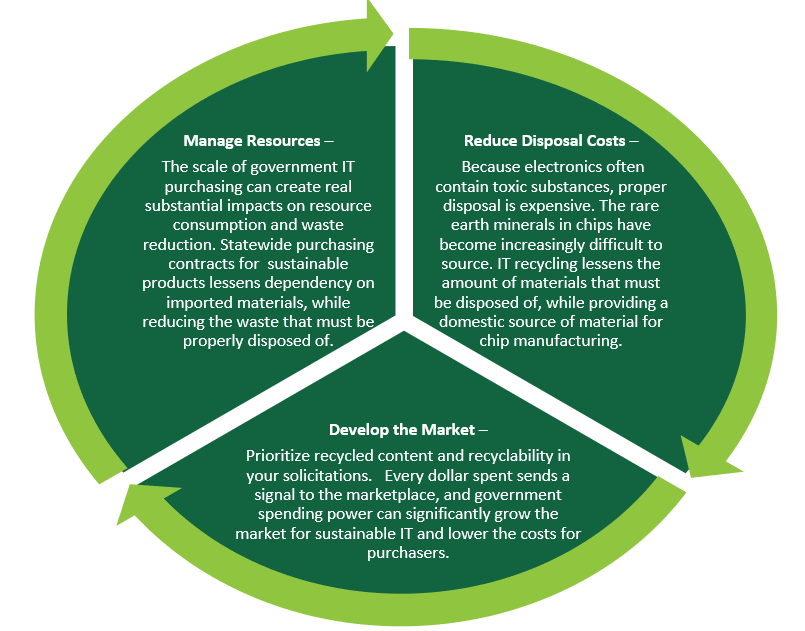
A More Sustainable IT Model
April 1, 2021
The Covid pandemic has underscored issues with U.S. reliance on supply chains abroad in many areas, including semiconductor manufacturing. In February, President Biden signed Executive Order 14017 to address supply chain vulnerabilities and a semiconductor shortage impacting a variety of industries like cellular devices, information technology, and automobiles.
Commonly known as chips, semiconductors are used to power electronics and facilitate their operational functions. Much of the world’s chips are manufactured in places like China, South Korea, and Singapore. The EO’s 100-day review is the first step in an effort to diversify the United States’ supply chain dependence for technology components such as rare earth minerals from China.
The lack of resilience in the IT supply chain makes domestic organizations more vulnerable to disruptions like the ones created by the Covid-19 pandemic and further illustrates that the traditional means of producing and purchasing IT is unsustainable in the long term.
Pulse is here to help you set up more sustainable sourcing solutions for your IT future.
Create a Circular IT Economy
One key way to lessen chip supply chain dependence is to recycle more electronic IT products here in the US while leveraging government purchasing power to grow the market for IT products manufactured from recycled materials. Transitioning technology from a dominantly linear economy to a more circular economy would produce benefits for purchasers and users.

UNICOR operates a nationwide full-service electronics recycling network. The U.S. EPA also recognizes e-Stewards and R2 as the accreditation standards for IT recycling. Service providers that carry one of these certifications are highly recommended.
Other tips for a more sustainable IT procurement process:
Use Excess Stock
Before determining that you must buy all new IT products, check for any surplus items that other offices or agencies may have. The U.S. General Services Administration requires purchasers to consider this option first as part of its sustainable procurement process. The GSAXcess® is a catalog system for purchasers to search the federal government’s available excess property for transfer. Similar catalog systems in states could be beneficial.
Lease Technology and Take-back Programs
Leasing IT equipment from the manufacturer or distributor ensures that the retirement process is built-in to the contract. Take-back related provisions should be inserted in the scope of-work for leased or purchased electronic equipment, wherever possible. Requiring suppliers to have, or to partner with, certified recycling networks should be part of the solicitation or evaluation criteria. For a sample of take-back contract language, read the GSA’s Federal Electronic Asset Takeback Guidance.
Use Ecolabels
Ecolabels provide widely recognized third-party certifications that establish a standard for technical performance and sustainability specifications, which save procurement teams valuable time and effort when developing solicitations. Two of the premier ecolabels for IT products are the EPA’s EnergyStar and GEC’s EPEAT label. Several certifying organizations offer benefit calculation tools to help determine potential environmental impact and budgetary savings. EPEAT factors in a myriad of criteria including recycled content, total lifecycle impacts, and rare conflict materials such as those used to make chips. GEC’s EPEAT benefits calculator is approved by the U.S. General Services Administration and can be used to help build the business case for your sustainable IT procurement efforts.
Cooperative Purchasing Opportunities
NASPO ValuePoint leverages purchasing power to impact the marketplace and create both budgetary and environmental savings. NVP offers cooperative contracts for EPEAT- certified IT products and services. According to the benefits calculator, participating governments shared a combined savings of over 20.7 million dollars in fiscal and environmental costs through these contracts in 2018.
You can learn more about sustainable procurement from the U.S. General Service Administration’s Sustainable Facilities Tool and the Green Procurement Compilation where you will find guidance for office electronics and electronic equipment leasing. Learn about certified electronics recyclers from the EPA’s website. For more information about EPEAT certified products and sustainable IT specifications, visit the Global Electronics Council.
